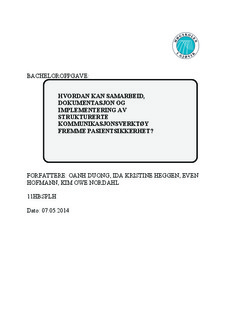Hvordan kan samarbeid, dokumentasjon og implementering av strukturerte kommunikasjonsverktøy fremme pasientsikkerhet?
Bachelor thesis
Permanent lenke
http://hdl.handle.net/11250/218125Utgivelsesdato
2014Metadata
Vis full innførselSamlinger
Sammendrag
NORSK: Introduksjon: Studier viser at pasientskade oppstår hos 16% av pasienter innlagt ved norske sykehus,
sammenlignet med et gjennomsnitt på 10% i vestlige land, og at kommunikasjonssvikt er årsaken til 70%
av oppståtte pasientskader.
Hensikt: Se hvordan samarbeid, dokumentasjon og implementering av strukturerte
kommunikasjonsverktøy, hovedsakelig ISBAR, kan fremme pasientsikkerheten.
Metode: Oppgaven er en litteraturstudie. Resultatet fra fire kvalitative, to kvantitative og en
observasjonsstudie presenteres. Aktuelle søkeord: ”communication”, ”patient safety” ,”hospital nursing
staff”, ”interprofessional relations”, ”work environment”, ”health
professionals”, ”hospitals”, ”assertiveness”, ”attitude”, teamwork”, ”patient care”.
Konklusjon: Samarbeid og kommunikasjon er viktige elementer i pasientsikkerhetsarbeid. Tverrfaglig
samarbeid kan forbedres gjennom simulering, og kommunikasjon kan forbedres gjennom bruk av
kommunikasjonsverktøy som f.eks. ISBAR. For å sikre pasientsikkerhet understrekes også viktigheten av
dokumentasjon. ENGLISH: Introduction: Studies have shown that 16% of patients admitted to Norwegian hospitals have suffered
injuries, compared to an average of 10% in other western countries. Studies have also shown that
communication failure is the reason behind 70% of patient injuries.
Purpose: The purpose of the study is to explore the effects of collaboration, documentation and
implementation of structured communication tools in regards to patient safety.
Method: The study is a literature review. Four qualitative, two quantitative and one observational study
have been analyzed and are presented in the results chapter. Search terms used to find research articles
include ”communication”, ”patient safety” ,”hospital nursing staff”, ”interprofessional relations”, ”work
environment”, ”health professionals”, ”hospitals”, ”assertiveness”, ”attitude”, teamwork”, ”patient care”.
Conclusion: Collaboration and communication are essential in ensuring patient safety. Interprofessional
collaboration can be trained through the use of simulation, and interprofessional communication can be
improved through the use of communication tools, such as ISBAR. In ensuring quality care and patient
safety, the importance of documentation is also emphasized.
